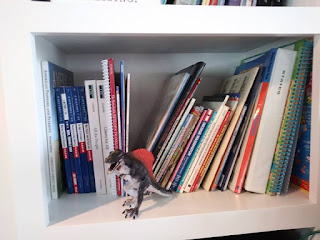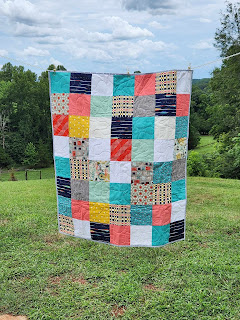The Homeschool Curriculum We Choose part 2
I promised you a hodge podge. Here we go:
If Daniel were in public school, he'd be in the 4th grade. In homeschool world there is less "grade" and more "level." Yes, this is why I get the blank-deer-in-the-headlights-stare when people ask me what grade he is in.
Math
We use Teaching Textbooks for math and that is really all Daniel has ever used. It's a computer based program (and is now moving to online and away from discs.) The is the one subject that I do not teach. For Daniel it's been the natural choice because he "gets" math easily. There are many arguments that the program is behind a level or two compared to other programs but I know many students that do very well with it. Some do their grade level or under to help cement skills and build confidence. We use two levels ahead of grade level. So Daniel is doing TT6 (started with TT4 in the second grade.) Teaching Textbooks provides a placement test to take the guess work out of level placement.
History
We are currently studying Early American History and there is so much out there! We primarily use America from the Beginning by Joshua Franklin and A History of US series by Joy Hakim. Both of these resources are very interesting (to both mom/teacher and student) but more importantly, full of truth. Real truth, hard truth, beautiful truth. No sugar-coating. A lot of history resources I came across represented America as the biggest, best, greatest ever that always did everything right (wrong!) or on the other end of the spectrum as a country who was inherently and forever evil because of its roots in slavery and its atrocities against Native Americans and African Americans. I'm thankful to have found the middle road and embarrassed to admit how much I have learned through teaching through these books.
In addition to the textbooks, we also use a variety of literature with an early American time setting. We used Sonlight for second grade and though I no longer use that curriculum in its entirety, we still use their book lists for readers and read alouds. We are currently using what would correspond with their Early American History which are from Cores D & E. The first picture shows some of the books we've already read this year and the second shows what's still on our "to read" list.
Science
Science is another one of those subjects (in addition to history) that can be difficult to find a textbook or program that feels similar to public school. A lot of science programs are unit studies that focus on a certain subject at a time. We are using Apologia's Exploring Creation with Anatomy and Physiology. I love this textbook and how it's written but I can't say I'm super confident that Daniel will retain much of it when we are done. Most of that is likely because of the subject and less because of the way it's presented. The Junior Notebooking Journal does help cement some of the concepts.
Language Arts
I have found a language arts curriculum that I LOVE, LOVE, LOVE! The Good and The Beautiful. And guess what, it's free for certain elementary school levels! With that being said, I'd gladly pay for it. In fact, this year I downloaded the free version and printed it and now I like it so much I wish I would have paid for the physical copy. We have a black and white laser printer so we miss out on the beautiful images. When we are ready for the next level, I will be purchasing it from the company. It is very teacher and student friendly. The lessons *feel* different each day so it doesn't get boring. It has created so much good dialogue between me and Daniel....and you try to have "dialogue" with a 9 year old boy. I just can't say enough good about this material. The name really says it all. The Good and The Beautiful is also a curriculum that doesn't necessarily correspond with grade level and is one where the placement test is essential!
We also use Fix-it-Grammar which is pretty much sentence diagramming 101. I'm not sure that I would have started it had I found TGTB first because it also addresses sentence diagramming but we have liked it and I've been impressed with what Daniel has learned from it.
And we plan to use Spelling Power. And here's where I'm going to be real. I've been "planning" to use it for a few months now. According to some friends, it's amazing and I have no doubt it is. But the teacher manual y'all. It's just so long. So as soon as I get through the "how to" we will use Spelling Power. I did recently administer the placement tests so we're well on our way, right?
Handwriting
Daniel learned to write in cursive last year using All About Handwriting's program. We are currently working through a handwriting and U.S. geography study in one and once that is complete I'm looking forward to transitioning to TGTB's handwriting workbook (which contains more than just handwriting) and beginning to learn typing skills.
Bible Here's another part where I've had to eat my own words, or maybe just thoughts, when it comes to homeschooling. When we first started I was afraid to have a religious aspect in EVERY thing we did because I didn't want Daniel growing up thinking it was shoved down his throat. I've recently become convicted of how wrong I was. I still don't desire to shove anything down any of my children's throats but the best thing I could ever teach them is that they have a Heavenly Father that loves them, a Heavenly Savior that died for them, and a Heavenly, Holy Spirit that guides them. I know that there have been times in my life that I thought I could do things on my own but not one day has passed where I haven't needed Him. If I can help my children develop habits of daily Bible reading while young, that will be much more important than anything else I ever teach them. Daniel and I use Apologia's Who is God and Can I Really Know Him? together and he uses BJU's Bible Truths on his own for daily reading and one worksheet a day. The BJU worktext is designed to go with a teacher manual but because the scripture is given for each workbook, I haven't seen where we've needed.Reading
And lastly we read. And read. And then read some more. For the last two years my goal has been at least 1 hour a day with me reading to Daniel for at least 20 minutes, Daniel reading to me for at least 20 minutes, and Daniel reading to himself for at least 20 minutes. In my mind, these are three very different skills and if he can train his mind to do all 3 well then he is set. Now that it's a habit, I usually read closer to an hour to him some days in addition to reading his textbooks.
A friend asked me recently if I taught Daniel or used an online program. When I answered that I taught everything except math, her next question caught me off guard. She asked how I had time to teach it and help him study. I really didn't know how to answer. We don't study, we just learn? That doesn't sound right. But yet that's how we approach all our work. The math program and language arts program we use are spiral meaning we will continue to cycle back over concepts and reinforce things we've already learned. I don't expect Daniel to remember all of the history we cover but I know in 4-5 years he'll cycle back to the same time period and build upon the knowledge he's already gained. As long as we're learning, we're good.













Comments
Post a Comment